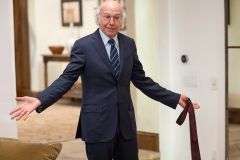The biggest draw of a hybrid is improved fuel economy over gas cars, especially in cities, where stop-and-go driving achieves better returns than highway driving. To put the 2025 Honda Civic Hybrid sedan’s EPA city rating of 50 mpg to the test, we took it into the heart of the most urban and populous city in the United States: New York.
But rather than sit in random gridlock to prove a point, we headed in with a specific route in mind: drive the entire length of Broadway as it traverses the city—in this case, through the boroughs of the Bronx and Manhattan.
Fifty mpg was the target, and it was one I was keen to beat.
Getty Images/Zamek/VIEWpress
Give My Regards to Broadway
You might not know this, but beyond Midtown’s famed Theater District, Broadway actually stretches from its Bowling Green origin at the tip of Lower Manhattan all the way up through the island, the Bronx, and into Westchester County. After a point in Sleepy Hollow, the road becomes Albany Post Road and runs to the state capital.
As the oldest north-south road in the city, clearly predating the grid pattern, it should come as no surprise that Broadway’s roots are Native American, established long before any European colonizers appeared.
“As a thoroughfare, Broadway can be traced back to the Native American Wickquasgeck Trail that was carved through the bush of Mannahatta,” Michelle Young wrote in her 2015 book Broadway, using the Lenape name for the island. “It became one of the two main streets formed during the settlement of the Dutch West India Company. Known at the time as de Heere Straat, or ‘Gentlemen’s Street,’ Broadway originated at Fort Amsterdam and followed a natural ridge of land that led northwards through the fields and farms of New Amsterdam.”
The Miriam and Ira D. Wallach Division of Art, Prints and Photographs: Picture Collection, The New York Public Library. (1840 – 1870). Nieuw Nederlandt.
Primarily, New York City was colonized from the south, so it would have been historically accurate to run this route northbound, starting at Bowling Green. But seeing as modern-day Broadway exclusively runs southbound starting at Columbus Circle, we instead started at the top of the Bronx in an attempt to drive as much of it as we could while keeping things within the city’s five boroughs.
The Bronx to Lower Manhattan
Westchester County shares an uneven land border with the Bronx, so after a gas station top-up in Yonkers, our red Civic cruised south along the western edge of Van Cortlandt Park in the Bronx before crossing the Harlem River via the Broadway Bridge onto Manhattan.
At the corner of 204th Street stands the Dyckman House, a Dutch Colonial–style farmhouse that was built sometime around 1784 and the oldest farmhouse remaining in Manhattan. Contrasting starkly against the surrounding urbanism, it serves as a reminder that New York City was once rolling hills and farmland. At one point, the Dyckman farm spanned roughly 250 acres.
MotorTrend’s 2025 Honda Civic Hybrid parked in front of the 1784 Dyckman House in Inwood.
I have long suspected but was thrilled to confirm the Civic Hybrid is one of the best city cars currently for sale. Not only does the electric low-end power help it scoot away from frequent red lights with ease, but waiting for them to turn green is actually a serene experience because there’s no cabin vibration from the engine idling.
Plus, the car’s short length means it’s easy to place and a dream to maneuver. It would almost make the perfect New York City taxi if it had just a little more rear legroom—and the Toyota Camry didn’t already have the market on lock.
From West 176th to 116th Streets, Broadway takes you past more choice landmarks. The United Palace theater, built in 1930, was specifically designed for screening movies to coincide with the golden age of Hollywood. It occupies an entire block in Washington Heights and is one of the most lavish in the city’s history.
A general view of the exterior of the United Palace Theater in New York City. (Photo by Ben Hider/Getty Images)
Restored facade of the Malcolm X and Dr. Betty Shabazz Memorial and Educational Center that depicts a statue of Neptune.
At 165th Street, you pass the Shabazz Center across the road’s median strip, which houses the former Audubon Ballroom and is the site of the Malcom X assassination. In Morningside Heights between 120th and 116th stands Barnard College, one of the original Seven Sisters all-women’s colleges, established in response to Columbia University’s refusal to admit female students until 1983.
Broadway begins to curve east past 78th Street. After passing The Ansonia, a breathtaking condominium building built around 1900 in the Beaux-Arts style, we hooked around for a quick hot dog at the original (and city’s last remaining) Gray’s Papaya at Broadway and 72nd Street.
The Ansonia, as viewed from street level on Broadway.
Anthony Bourdain once called the 72nd Street Gray’s Papaya his second home.
The Gray’s Papaya Recession Special: two franks and a medium tropical drink, $7.50 plus tax.
We pulled over in front of the Broadway Theater at the corner of 53rd Street to admire one of the few Broadway theaters physically on Broadway the street—and to steel ourselves for the next 30 or so blocks of our journey.
Of the 41 active Broadway theaters, only a very small handful of them are actually located on Broadway itself.
Compared to the relatively carefree drive down from the Bronx, this is where the majority of the traffic is. There’s enough gridlock to test even the calmest driver’s patience, and in the little Civic, it was sometimes hard to see around the massive, double-parked box trucks that provide New Yorkers with their last-mile deliveries. Thankfully, you can’t make a right on red anywhere in the five boroughs unless explicitly stated, so the gridlock isn’t worse.
Heading into Times Square.
Any New Yorker will agree: We go out of our way to avoid Times Square if we can. Forget driving. But since Broadway runs directly through this hellscape, the rules of the assignment dictated we must persist. However, portions of the road are broken up by pedestrian-only plazas (including Times Square), so we juked over to Fifth Avenue, passed the Flatiron Building at 23rd Street, and got back on Broadway at the bottom of Union Square Park.
Contrary to popular belief, the Flatiron Building was not the world’s first skyscraper. It’s also temporarily closed due to renovations to turn it from an office building into luxury condos.
This is probably where the Civic’s torque delivery came in the handiest. Sometimes I needed to make a split-second merge, and the powertrain’s snappiness off the line got us in tidily. The car’s small footprint ensured we were never—never—blocking the box.
Cross East Houston Street and Manhattan’s famous grid system of avenues and streets ceases. This is the oldest part of the city, the area first colonized by the Dutch upon their arrival and the British after that. City Hall, the neo-Gothic styled Woolworth Building, and Trinity Church all claim snatches of land off these breathtakingly claustrophobic streets that wear near-mythical New York names—Vesey, Stone, Fulton, Wall.
The gilded entrance of the Woolworth Building.
The Woolworth Building’s neo-Gothic facade.
Think there’s lost treasure, hidden by the Freemasons, beneath Trinity Church?
At 1 Broadway, across from Bowling Green, the test concluded, and we parked the Civic for a photo, feeling very much like we just went backwards in time. It’s wild to think about how much steel, concrete, and glass is paved over what began as a hilly, forested, and marshy island.
The Civic at 1 Broadway in Lower Manhattan.
“At the foot of the [Wickquasgeck] trail was a large elm that w





